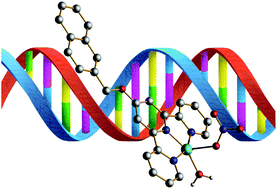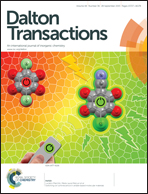The effect of potential supramolecular-bond promoters on the DNA-interacting abilities of copper–terpyridine compounds†
Abstract
Three copper(II) coordination compounds have been prepared from three different 2,2′:6′,2′′-terpyridine-based ligands, which have been selected to investigate the potential role of supramolecular interactions on the DNA-interacting and cytotoxicity properties of the corresponding metal complexes. Hence, the ligands 4′-((naphthalen-2-yl)methoxy)-2,2′:6′,2′′-terpyridine (Naphtpy) and 4′-((1H-benzo[d]imidazol-2-yl)methoxy)-2,2′:6′,2′′-terpyridine (Bimztpy) have been synthesized from commercially-available 4′-chloro-2,2′:6′,2′′-terpyridine (Cltpy), and their copper(II) complexes have been obtained by reaction with copper(II) nitrate. The DNA-interacting abilities of the corresponding compounds [Cu(Cltpy)(H2O)(NO3)2] (1), [Cu(naphtpy)(NO3)(H2O)](NO3)(MeOH) (2) and [Cu(bimztpy)(NO3)(H2O)](NO3) (3) have been investigated using different techniques, and cytotoxicity assays with several cancer cell lines have revealed interesting features, viz. the more efficient complex is 2, which although it does not act as a DNA cleaver, displays the most effective DNA-interacting and cytotoxic properties, compared to 1 and 3.


 Please wait while we load your content...
Please wait while we load your content...